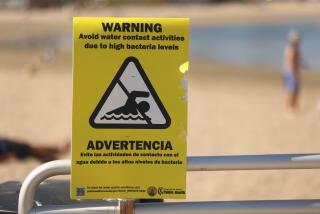Wasrning Issued on Fish Caught Off Southland
The state Department of Health Services on Thursday warned that fish caught in and around Santa Monica and San Pedro bays may be dangerously contaminated by toxic materials such as DDT, and said that consumption of them should be limited, especially for pregnant women and children.
Officials stopped short of recommending a fishing ban in the bays, but called on the state Department of Fish and Game to consider posting warning signs and closing certain areas to fishing.
The warning was issued on the heels of several reports showing higher-than-normal levels of DDT in fish caught near sewage outfalls in the bays. Officials also cited recent reports of toxic dumping in the bay off Santa Catalina Island, and said that more studies may be needed to âreliably projectâ the health hazards of sportfishing in the Santa Monica Bay-Palos Verdes Peninsula area.
Commercial Products
Dr. Kenneth W. Kizer, director of health services, stressed that fish sold in restaurants and markets should not be affected because most commercial fishing occurs beyond the bays.
âAs far as we know (commercial fishing) is not a problem,â Kizer said.
The officials recommended that consumers stop eating any fish caught around the Whites Point sewage outfall near the Palos Verdes Peninsula, the Gerald Desmond Bridge in Long Beach Harbor and Cabrillo Pier in Los Angeles Harbor--the areas where DDT and other toxic levels are highest. They also said that one of the most abundant species of fish found in the bays, the white croaker or tom cod, has extremely high levels of contamination and should not be eaten.
Officials stressed that most fish caught at other locations in the bays could still be consumed, but they said several precautions should be taken.
Precautions Urged
Pregnant women, as well as women who are nursing or are of child-bearing age, and children were advised to eat no more than one local sport fish taken from the bays per month. Other people were advised to restrict their intake of the fish to no more than one or two meals per week. In addition, officials recommended that consumers remove fatty tissue and skin from all fish, restrict themselves to fish that has been baked or broiled and avoid eating the livers of any fish.
âWe may be criticized for being overly restrictive,â Kizer said. âBut we want to be on the side of protecting the public health.â
Kizer said the Health Services Department checked for âdangerousâ levels in marine life of DDT and PCB, two toxic substances that can cause cancer and other diseases. The department based its report on fish studies conducted in 1980 and 1981. The staff also consulted with the Department of Fish
and Game, the Regional Water Quality Control Board, the Environmental Protection Agency and the Southern California Coastal Water Research Project.
Assemblyman Tom Hayden (D-Santa Monica), chairman of a state task force investigating bay pollution, called the Health Services report a âcautious confirmation of our worst fears.â He questioned why officials waited so long to assess the health risks.
âI think they did a thorough job of examining the existing data,â Hayden said. âThe problem is the data has been around for five years. Who the hell has been in charge of warning the public?â
Data Needed
Health Services officials conceded Thursday that updated information is needed. The report they issued at a news conference at the Santa Monica Pier recommended that officials study contamination levels in different species of fish, the relationship between cooking and contamination levels, the influence between a fishâs age and its contamination level and the effect of contamination levels in different geographic areas.
The report also called on the Los Angeles County Department of Health Services to obtain current information on the consumption of sport fish âamong non-English speaking groups who may consume larger amounts of these fish.â
Whose Responsibility
In the meantime, Hayden said that warnings should be posted immediately. But officials could not agree on what public agency has the ultimate responsibility for enforcing such actions.
Health Services officials said the authority rested with the Fish and Game Department. A Fish and Game spokeswoman disagreed, saying local agencies also have to approve whatever warnings are issued. And local health officials referred inquires back to the state Health Services Department.
In Santa Monica, where the City Council already has authorized its staff to draft the language for a warning sign, one councilman said that people who fish should be advised to âlook elsewhere for protein.â
âNobody should panic,â said Councilman James Conn, who attended the news conference. âBut itâs also clear that nobody should be eating these fish.â
Kizer advised caution, but said the evidence does not suggest that all fish are dangerous. âI would eat some of the fish here,â he said. âBut if it were my wife and kids involved, I would also follow the guidelines.â
FISH WARNING
These guidelines announced by health officials are aimed at reducing exposure to toxic chemicals that have been found in small quantities in sport fish.
Avoid eating white croakers and the liver of any fish.
Avoid eating any fish caught in areas immediately around White Point outfall near the Palos Verdes Peninsula, Gerald Desmond Bridge in Long Beach Harbor and Cabrillo Beach Pier.
Pregnant or nursing women and children should eat no more than one meal per month of any local sport fish, not including white croaker).
Those who routinely eat local sport fish should reduce consumption of fish to one to two meals per week.
Skin and fatty tissue should be removed when preparing fish caught in these areas.
Fish should be cooked by baking or broiling on a rack.
More to Read
Sign up for Essential California
The most important California stories and recommendations in your inbox every morning.
You may occasionally receive promotional content from the Los Angeles Times.










